Steam engine
A steam engine is a heat engine that makes use of the thermal energy that exists in steam, converting it to mechanical work. Steam engines were used in pumps, locomotive trains and steam ships, and were essential to the Industrial Revolution. They are still used for electrical power generation using a steam turbine.
A steam engine needs a boiler to boil water to produce steam under pressure. Any heat source can be used, but the most common is a wood or coal fire. Anything that can be burned can be used as fuel for the fire: paper, trash, used crankcase oil, ground-up corncobs, manure, natural gas, gasoline, high proof alcohol, dry grass, hay, dry weeds, etc. The steam expands and pushes against a piston or turbine, whose motion does the work to turn the wheels.
Invention
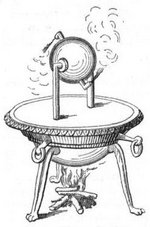
The first steam device, the aeolipile, was invented by Heron of Alexandria, a Greek, in the 1st century AD, but used only as a toy.
Denis Papin, a French physicist, built a working model of a steam engine after observing steam escaping from his pressure cooker in about 1679. Sir Samuel Morland also developed ideas for a steam engine during the same period. Early industrial steam engines were designed by Thomas Savery (1698), Thomas Newcomen (1712), and James Watt (1769), each adding new refinements. In 1807, Robert Fulton used the steam engine to power the first commercially successful steamship.
Early engines worked by the vacuum of condensing steam, whereas later types (such as steam locomotives) used the power of expanding steam.
Use and development
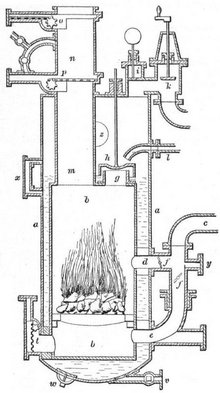
The first industrial applications of the vacuum engines were in the pumping of water from deep mineshafts. The Newcomen engine operated by admitting steam to the operating chamber, closing the valve, and then admitting a spray of cold water. The water vapor condenses to a much smaller volume of water, creating a vacuum in the chamber. Atmospheric pressure, operating on the opposite side of a piston, pushes the piston to the top of the chamber. In mineshaft pumps, the piston was connected to an operating rod that descended the shaft to a pump chamber. The oscillations of the operating rod are transferred to a pump piston that moves the water, through check valves, to the top of the shaft.
The first significant improvement was creation of a separate condensing chamber with a valve between the operating chamber and the condensing chamber. This improvement was discovered in Birmingham, England by James Watt who was a member of the Lunar Society. His discovery and its development increased the efficiency of the engine. The next improvement was the replacement of manually operated valves with valves operated by the engine itself.
Such early
vacuum, or condensing, engines are severely limited in their efficiency but are
relatively safe since the steam is at very low pressure and structural failure
of the engine will be by inward collapse rather than an outward explosion. Their
power is limited by the ambient air pressure, the displacement of the working
chamber, the combustion and evaporations rates, and the condenser capacity. The
maximum theoretical efficiency is limited by the relatively low boiling point
of water at near atmospheric pressure (100 °Celsius, 212 °Fahrenheit).
Further improvements in efficiency came with the use of pressurized steam, which
used a far greater pressure, but more importantly (from a thermodynamic standpoint)
operates at a higher temperature differential. But with this added pressure came
much danger and many disasters due to exploding boilers and machinery. The most
important refinement at this point was the safety valve, which releases
excess pressure. Reliable and safe operation came only with a great deal of experience
and codification of construction, operating, and maintenance procedures.
Technology
Boilers
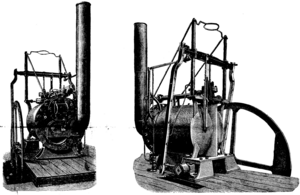
Boilers are of two types:
- Fire tube construction is typical of early maritime installations for boats and ships and the boilers of steam locomotives. In a fire tube boiler, the hot gases from the firebox (a combustion chamber) are passed through tubes connecting perforated end plates. The gases then enter a smokebox or smoke chest and pass on to a smokestack. The boiler may be vertical or horizontal. For an example of a vertical boiler of this type observe the boiler in the small riverboat used in the movie The African Queen. This type is also used in some boilers that provide steam for steam heating of a building and was also used in the steam shovel. Locomotives and early ships used a horizontal orientation and early ships would usually require a tall smokestack to provide draft, not having a fan to provide a forced draft. In a steam locomotive the draft is generally augmented at startup by directing the steam exhaust through the smokestack, which provides a partial vacuum.
- In a water tube boiler the water is heated in multiple tubes exposed to the hot gases. The tubes are joined to a steam collector chamber at the top. A significant advantage of this type is that there is less chance of catastrophic failure, as there is not a great amount of water in the boiler, nor are there large mechanical elements subject to failure. There may be additional tubes above the collector in the upper portion of the hot gas exhaust - this device, called a superheater, provides additional temperature (and hence pressure) and increases the thermal efficiency of the entire mechanism. Superheaters were also used in some of the later versions of the steam locomotive.
There is also another division between boilers: natural aspiration, which is nearly all of them, and forced-draft, or "pressure-fired" boilers. This technology, equivalent to supercharging for an internal combustion engine, was developed by the Germans and acquired by the US Navy to be used in some frigates built after the Second World War. In it, a fan is used to increase the rate of burning; the boiler must be constructed to get that extra heat to the water. An engine using this kind of boiler has the greatest acceleration from a standing start of any marine powerplant.
Engines
High pressure steam engines are of various types but most are either reciprocating piston or turbine devices.
Reciprocating
Double-acting
After the development of pressurized steam technology, the next major advance was to the use of double-acting pistons, with pressurized steam admitted alternately to each side while the other side is exhausted to the atmosphere or to a condenser. Most reciprocating engines now use use this technology. Power is removed by a sliding rod, sealed against the escape of steam. This rod in turn drives (via a sliding crosshead bearing) a connecting rod connected to a crank to convert the reciprocating motion to rotary motion. An additional crank or eccentric is used to drive the valve gear, usually through a reversing mechanism to allow reversal of the rotary motion.
When a pair of double acting pistons is used, their crank phasing is offset by 90 degrees of angle; this is called quartering. This ensures that the engine will always operate, no matter what position the crank is in.
Some ferryboats have used only a single double-acting piston, driving paddlewheels on each side by connection to an overhead rocker arm. When shutting down such an engine it was important that the piston be away from either extreme range of its travel so that it could be readily restarted.
Multiple expansion
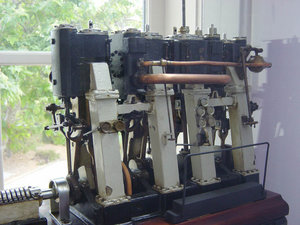
Another type uses multiple (typically three) single-acting cylinders of progressively increasing diameter and stroke (and hence volume).
High pressure steam from the boiler is used to drive the first and smallest diameter piston downward. On the upward stroke the partially expanded steam is driven into a second cylinder that is beginning its downward stroke. This accomplishes further expansion of the relatively high pressure exhaust from the first chamber. Similarly, the intermediate chamber exhausts to the final chamber, which in turn exhausts to a condenser.
The image at the right shows a model of such an engine. The steam travels through the engine from left to right. The valve chest for each of the first two cylinders is to the left of the corresponding cylinder while that of the third is to the right.
One modification of the triple-expansion engine is to use two smaller pistons that sum to the area of the third piston to replace it. This results in the more balanced unit of a total of four pistons arranged in a vee-configuration.
The development of this type of engine was important for its use in steamships, for the condenser would, by taking back a little of the power, turn the steam back to water for its reuse in the boiler. Land-based steam engines could exhaust much of their steam and be refilled from a fresh water tower, but at sea this was not possible. This sort of engine dominated merchant marine applications prior to and during World War II. It even was used in warships before the HMS Dreadnought of 1905.
Uniflow
Another type of reciprocating steam engine is the "uniflow'' type. In this, valves (which act similarly to those used in internal combustion engines) are operated by cams. The inlet valves open to admit steam when minimum expansion volume has been reached a the top of the stroke. For a period of the crank cycle steam is admitted and the poppet inlet are then closed, allowing continued expansion of the steam during the downstroke. Near the bottom of the stroke the piston will expose exhaust ports in the side of the cylindrical chamber. These ports are connected by a manifold and piping to the condenser, lowering the pressure in the chamber to below that of the atmosphere. Continued rotation of the crank moves the piston upward. Engines of this type always have multiple cylinders in an inline arrangement and may be single or double acting. A particular advantage of this type is that the valves may be operated by the effect of multiple camshafts, and by changing the relative phase of these camshafts, the amount of steam admitted may be increased for high torque at low speed and may be decreased at cruising speed for economy of operation, and by changing the absolute phase the engine's direction of rotation may be changed. The uniflow design also maintains a constant temperature gradient through the cylinder, avoiding passing hot and cold steam through the same end of the cylinder. (The uniflow concept is also employed in two stroke supercharged diesel engines used for marine, locomotive, and stationary applications. Such diesels do not need the economizer feature and use a simpler sliding camshaft for reversing.)
Turbine type
Steam turbines for high power applications will use a number of rotating disks containing propeller-like blades at their outer edge. These moving "rotor" disks alternate with stationary "stator" blade rings affixed to the turbine case that serve to redirect the steam flow for the next stage. Owing to the high speed of operation such turbines are usually connected to a reduction gear to drive another mechanism such as a ship's propeller. Steam turbines are more durable, smoother operating, and require far less maintenance than reciprocating engines. A limited number of steam locomotives were manufactured that used turbine technology. While these engines had the typical rods connecting the drive wheels they had no driving rods or cylinders, and no valve links or reversing gear, appearing strangely incomplete to most observers. (This locomotive was modeled by Lionel but proved unpopular due to its simple appearance — modelers preferred the complexity and excited motion of the more conventional types).
Rotary type
The Quasiturbine is a recent concept of rotary steam engine, with the mechanical concept also applicable as an internal combustion engine.
Steam powered vehicles
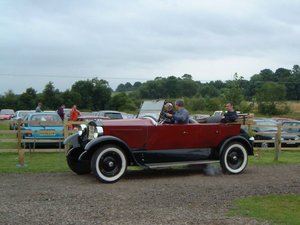
Nicolas-Joseph Cugnot demonstrated the first functional self-propelled steam vehicle, his "steam wagon", in 1769. Arguably, this was the first automobile. While not generally successful as a transportation device, the self-propelled steam tractor proved very useful as a self mobile power source to drive other farm machinery such as grain threshers or hay balers.
Steam engine powered automobiles continued to compete with other motive systems into the early decades of the 20th century. However steam engines are less favored for automobiles, which are generally powered by internal combustion engines, because steam requires at least thirty seconds (in a flash boiler) or so to develop pressure.
On February 21, 1804 at the Pen-y-Darren ironworks in Wales, the first self-propelled railway steam engine or steam locomotive built by Richard Trevithick was demonstrated.
Advantages
The strength of the steam engine for modern purposes is in its ability to convert heat from almost any source into mechanical work. Unlike the internal combustion engine, the steam engine is not particular about the source of heat. Most notably, without the use of a steam engine nuclear energy could not be harnessed for useful work, as a nuclear reactor does not directly generate either mechanical work or electrical energy - the reactor itself simply heats water. It is the steam engine which converts the heat energy into useful work. Steam may also be produced without combustion of fuel, through solar concentrators. A demonstration power plant has been built using a central heat collecting tower and a large number of solar tracking mirrors, (called heliostats).
Similar advantages are found in a different type of external combustion engine, the Stirling engine, which offers efficient power in a compact engine, but which is difficult to operate over a wide range of operating conditions, difficulties which are readily addressed by the modern hybrid vehicle.
Steam locomotives are especially advantageous at high elevations as they are not especially adversely affected by the lower atmospheric pressure. This was inadvertently discovered when steam engines operated at high altitudes in the mountains of South America were replaced by diesel-electric engines of equivalent sea level power. They were quickly replaced by much more powerful locomotives capable of producing sufficient power at high altitude.
In Switzerland (Brienz Rothhorn) and Austria (Schafberg Bahn) new rack steam locomotives have proved very successful. They were designed based a 1930s design of Swiss Locomotive and Machine Works (SLM) but with all of today's possible improvements like roller bearings, heat insulation, light-oil firing, improved inner streamlining, one-man-driving and so on. These resulted in 60 percent lower fuel consumption per passenger and massively reduced costs for maintenance and handling. Economics now are similar or better than with most advanced diesel or electric systems. Also a steam train with similar speed and capacity is 50 percent lighter than an electric or diesel train, thus, especially on rack railways, significantly reducing wear and tear on the track. Also, a new steam engine for a paddle steam ship on Lake Geneva, the "Montreux" was designed and built, being the world's first ship steam engine with an electronic remote control. The steam group of SLM in 2000 created a wholly-owned company called DLM to design modern steam engines and steam locomotives.
Efficiency
Clearly, no pure heat engine can be more efficient than the Carnot cycle, where the efficiency depends on the temperature difference. Hence, steam engines should ideally be operated at the highest steam temperature possible, and release the waste heat at the lowest temperature possible.
In practice, a steam engine exhausting the steam to atmosphere will have an efficiency (including the boiler) of 5% but with the addition of a condenser the efficiency is greatly improved to 25% or better. A power station with exhaust reheat, etc. will achieve 30% efficiency. Combined cycle in which the burning material is first used to drive a gas turbine can produce 60% efficiency, and cogeneration in which the residual steam is used for heating can produce up to 90% efficiency; beating the Carnot cycle by a comfortable margin.
One source of inefficiency is that the condenser causes losses by being somewhat hotter than the outside world, although this can be mitigated by condensing the steam in a heat exchanger and using the recovered heat, for example to pre-heat the air being used in the burner of an external combustion engine.
The operation of the engine portion alone is not dependant upon steam; any pressurised gas may be used. Compressed air is sometimes used to test or demonstrate small model "steam" engines.
See also
- Timeline of steam power
- Newcomen steam engine
- Watt steam engine
- Steam power during the Industrial Revolution
- Stationary steam engine
- Steam donkey
- Steam Locomotive for details of steam powered railway 'engines'
- Crosshead bearing
- steam car
- Stanley Steamer
- Live steam
External links
- Interactive Steam Engine (http://www.avero.de/?links/dampfmaschine) See how it works and manipulate the speed
- Animated engines - Illustrates a variety of steam engines (http://www.keveney.com/Engines.html)
- The World's Smallest Steam Engine (http://www.fantasyarts.net/nanotechnology-gallery.htm)
- The Most Suppressed Invention (http://www.mikebrownsolutions.com/steamart.htm)
- A history of the growth of the steam-engine (http://www.history.rochester.edu/steam/thurston/1878/Chapter5.html)
- Uniflow locomotives (http://www.dself.dsl.pipex.com/MUSEUM/POWER/uniflow/uniflow.htm)
- Steam powered lawn mower (http://www.dself.dsl.pipex.com/MUSEUM/TRANSPORT/mower/mower.htm)
- Steamboat revival on Lake Geneva (http://www.cincinnati.com/travel/stories/053099_steamer.html)
